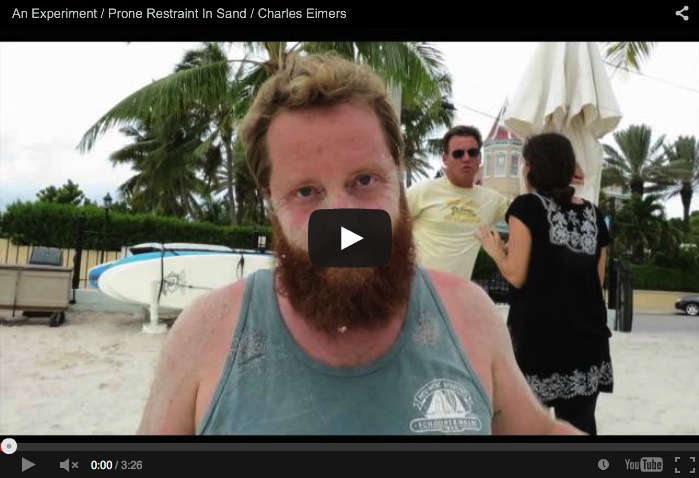REENACTMENT POINTS TO ASPHYXIATION
by Arnaud and Naja Girard…….
“Your safe word is “no” and if you can’t talk, move your arms.” The woman lies down on the beach resting on her stomach, hands behind her back. To be clear, we’re not shooting a bondage movie. This is South Beach, at the end of Duval Street, where 61-year-old Charles Eimers died last Thanksgiving Day while being arrested by Key West police officers. The woman on the sand is Naja Girard of The Blue Paper. We were trying to understand, through a reenactment, the most troubling part of the tragedy: the cause of death itself.
Medical Examiner E. Hunt Scheuerman’s autopsy report shows no physical evidence that can directly establish the cause of Eimers’ death. However, circumstantial evidence led him to rule out asphyxiation.
This is what he wrote:
“FDLE’s investigation concluded that his face was not forced into the sand, but rather, as he struggled, his face moved back and forth across the sand. Audio recordings from the event revealed that Mr. Eimers repeatedly said “No.” Such verbalization would not have been possible if he had been smothering in the sand.”
In his notes, the Medical Examiner explained that he didn’t review any of the actual audio taped interviews himself, “as they are not my work product. Her [FDLE’s agent Kathy Smith’s] impression of interviews is what I will use.”
Relying exclusively on FDLE agent Kathy Smith, the Medical Examiner concluded that since Eimers didn’t die of asphyxiation, he must have succumbed to cardiac arrest due to a sudden abnormal heart rhythm called ventricular fibrillation, [V-fib] even though the AED supplied by the restaurant, which had been connected immediately to Eimer’s chest at the scene, clearly indicated that his heart was not showing any signs of V-fib.
So, our question was this: Can a person, lying prone in the sand, actually keep breathing and talking even though he has 400-500 pounds of police officer resting on his shoulders and back?
And, as you can see in the video of our experiment, the answer is clearly “No.” Without the ability to lift your shoulders off the sand, your chin digs a hole in the sand with each back and forth movement and scoops up more sand. In two moves, no matter how much you try to raise your head, your face is completely buried. The experiment makes it clear that anyone in this situation would rapidly die of asphyxiation.
Now, let’s compare our experiment with the circumstances of Eimers arrest and let’s verify whether Charles Eimers had the ability to lift his shoulders so that he would not in fact have buried his nose and mouth in the sand.
According to police reports, Eimers was face down in the sand when Seargent Frank Zamora noticed he had turned blue. Three police officers were reportedly putting their weight on Eimers upper torso and shoulders.
“Sgt. Zamora and I,” wrote Officer Gabriel Garrido in his Incident Report, “remained in control of his [Eimers’] upper body,” Indeed, Sgt. Zamora confirmed, “I assisted by holding the subject down by placing my right knee on his left shoulder.” In the cell phone video shot by a bystander, a third officer is seen with both knees fixed on Eimers’ left upper torso. His feet are barely touching the ground, which indicates that all of his weight is on Eimers upper body.
At that point, Officer Thaddeus Calvert observed, “I saw that the suspect was trying to leverage his feet against the beach in an attempt to turn his body around. I grabbed the suspect’s left foot and turned it in a counter direction to assist in keeping him stabilized.”
Three officers would then “assist” by preventing Eimers from turning toward the air: Officer Nicholas Galbo [who relieved Officer Thaddeus Calvert], and Officer Matthew Johnson [if we exclude Officer Wanciak, who obviously, when reading between the lines of her report, didn’t feel like being at the scene any longer and left.]
Clearly, the situation on Thanksgiving fit the parameters of our experiment: Eimers was face down in the dry sand and a considerable force was keeping him from raising his shoulders up and away from the sand. As we have learned, in those conditions, his chin would have quickly dug an asphyxiation hole in the sand.
Even if one disregards the statements made by multiple eyewitnesses about Eimers being elbowed in the back of the head, tased, and having his head held down in the sand by an officer, the simple fact that the officers admit in their incident reports that Eimers’ shoulders were pinned down in the sand and he was moving his head from side to side can only lead to one conclusion about what occurred: A horrible death by suffocation in the dry sand on South Beach.
It appears about certain that anybody in a like situation, regardless of his or her age or physical condition, would have suffered a similar fate.
As suggested by one eyewitness from Maryland who was seated only 10-15 feet away from Mr. Eimers when he turned blue and stopped breathing, “KWPD should never use prone restraint again on sand.”
It is now up to the Grand Jury to decide whether charges should be brought against any of the police officers.
Stay tuned.
~~~~~~~~~~~~~~
To access all Blue Paper coverage of the death of Charles Eimers click here.
DID YOU LIKE THIS STORY? SUPPORT THE BLUE PAPER
Help us continue to bring you local investigative journalism… Click on the image to make a donation [NOT tax deductible].



